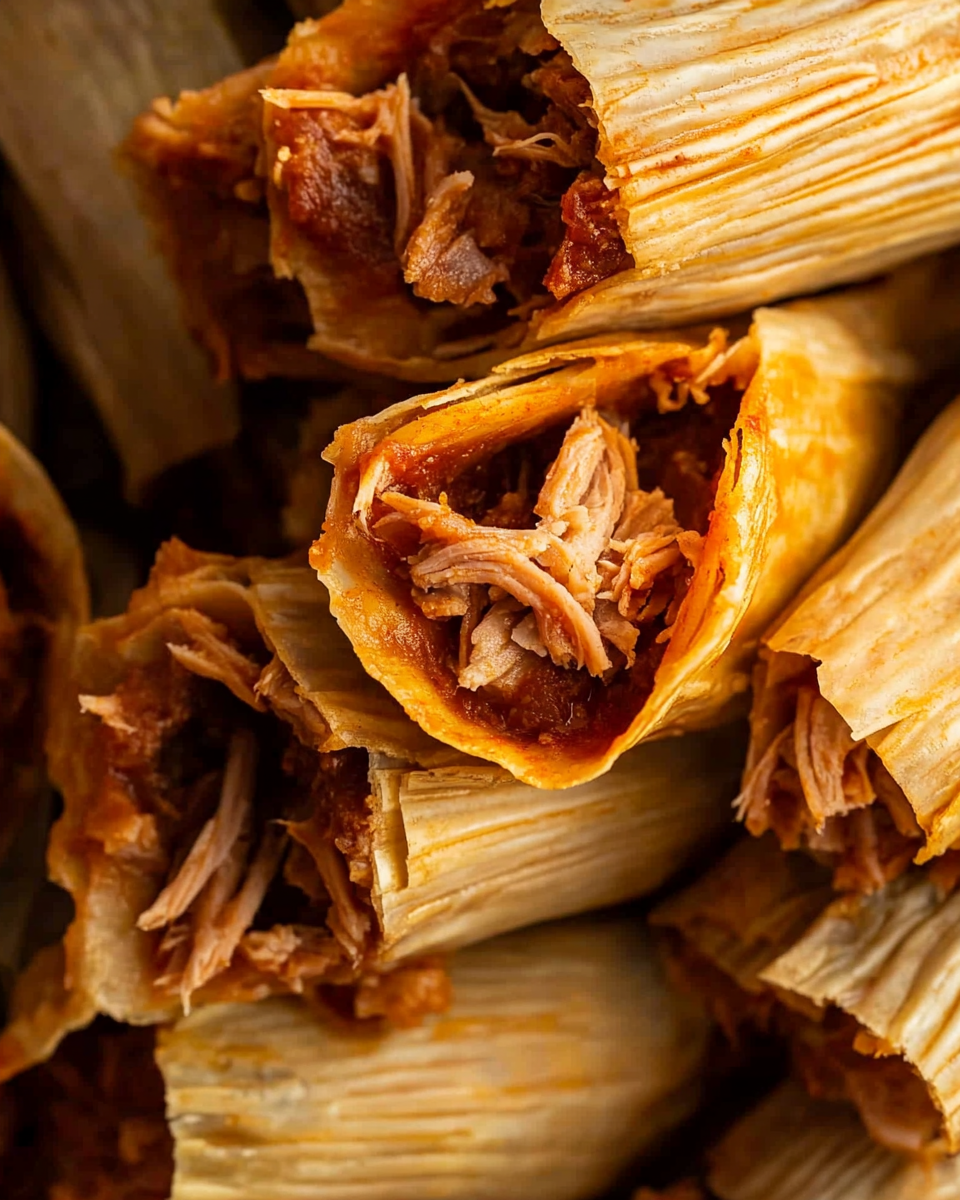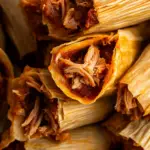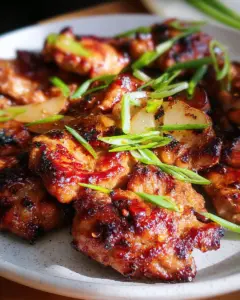Pork Tamales Rojos stand as one of Mexico’s most cherished culinary treasures. These steamed bundles of joy feature tender shredded pork simmered in a robust red chile sauce, enveloped in a light and fluffy masa dough, all wrapped in corn husks. What makes this dish special is the harmonious blend of guajillo, ancho, and pasilla chiles that create a sauce with deep, smoky flavors and just the right amount of heat. The process of making tamales often becomes a family affair, with generations gathering to prepare these delicious parcels for holidays, celebrations, or weekend meals. While the preparation requires time and patience, the results reward your efforts with every flavorful bite.

Preparation Phase & Essential Tools
Creating perfect Pork Tamales Rojos begins with gathering the right equipment. Each tool serves a specific purpose in achieving authentic results.
Essential Tools and Equipment
- Large Dutch oven or stockpot: Ideal for braising the pork shoulder to perfect tenderness while allowing the chile sauce to reduce properly.
- High-powered blender: Necessary for creating a smooth, lump-free chile purée that forms the base of your flavorful sauce.
- Stand mixer or large mixing bowl: Crucial for achieving the light, airy texture of the masa dough. A stand mixer saves time and effort when whipping the lard.
- Steamer pot with insert: The traditional cooking method for tamales. A large steamer pot accommodates multiple tamales at once.
- Fine-mesh sieve: Helps strain the chile purée for a velvety smooth sauce without any unwanted bits.
- Large bowl for soaking corn husks: Ensures the husks become pliable enough for folding without tearing.
Why These Tools Matter
The Dutch oven’s heavy bottom prevents burning during the long simmering process, while the blender transforms dried chiles into a rich, complex sauce base. A stand mixer incorporates air into the lard, creating the signature fluffy texture of good masa. The steamer pot’s tight seal ensures even cooking, and the fine-mesh sieve guarantees your sauce has a professional-quality texture. Properly soaked corn husks prevent sticking and make assembly much easier.
Preparation Tips for Success
Before diving into the recipe, consider these professional tips:
- Soak corn husks thoroughly: Submerge them in very warm water for at least one hour, weighing them down with a plate to keep them fully immersed.
- Prep ingredients in advance: Measure all spices and chop vegetables before starting to streamline the cooking process.
- Work with room temperature lard: This ensures it whips up light and incorporates evenly into the masa.
- Reserve time for overnight marinating: Letting the cooked pork sit in its sauce overnight deepens the flavors significantly.
- Organize your workspace: Tamale-making goes smoother when you have separate stations for husks, masa, and filling.
Ingredients List
For the Corn Husks:
- 50 dried corn husks (plus extras for lining the steamer)
For the Pork Rojo Filling:
- 5 pounds pork shoulder (boneless), cut into 1-inch cubes
- 2 teaspoons kosher salt (for seasoning pork)
- 4 tablespoons vegetable oil (for browning)
- 12 dried guajillo chiles (about 12 tablespoons when ground)
- 4 dried ancho chiles (about 4 tablespoons when ground)
- 4 dried pasilla negro chiles (about 4 tablespoons when ground)
- 6 cups water or chicken stock (divided use)
- 6 cloves garlic (peeled)
- 2 white onions (peeled and quartered)
- 2 jalapeños (stems removed)
- 1 tablespoon Chimayo chili powder (optional but recommended)
- 4 teaspoons ground cumin
- 4 teaspoons Mexican oregano (regular oregano works if unavailable)
- 2 tablespoons apple cider vinegar (for brightness)
For the Masa Dough:
- 2 cups lard (room temperature)
- 4½ teaspoons baking powder
- 1 tablespoon kosher salt
- 8 cups Maseca (instant corn masa flour, about 2 pounds)
- 1 cup reserved pork rojo sauce (for flavor and color)
- 7 cups liquid (water, reserved cooking liquid, or broth)
Step-by-Step Preparation
Making the Pork Rojo Filling
- Prepare the pork: Cut the pork shoulder into uniform cubes and season generously with kosher salt. Let sit while you prepare other ingredients.
- Toast and soak the chiles: Remove stems and seeds from dried chiles (leave some seeds for more heat if desired). Briefly toast them in a dry skillet to enhance their flavor, then soak in boiling water for 30 minutes until softened.
- Create the chile purée: Drain the chiles, reserving 1 cup of soaking liquid. In a blender, combine the softened chiles with garlic, onions, jalapeños, spices, and liquids. Blend until completely smooth, then strain through a fine-mesh sieve for optimal texture.
- Cook the pork: Heat oil in a Dutch oven over medium-high heat. Brown the pork in batches to develop flavor. Return all pork to the pot, add the chile purée and remaining stock. Bring to a boil, then reduce to a simmer, cover, and cook for 1 hour until pork is fork-tender.
- Finish the filling: Once cooked, remove pork from sauce and shred using two forks. Mix the shredded pork back into the sauce, stir in apple cider vinegar, and adjust seasoning. For best results, refrigerate overnight to allow flavors to meld.
Preparing the Masa Dough
- Whip the lard: In a stand mixer or large bowl, beat the room-temperature lard until light and fluffy, resembling whipped cream. This aeration is crucial for tender tamales.
- Incorporate dry ingredients: Mix in the baking powder and salt until fully combined with the lard.
- Build the masa: Alternately add Maseca and liquid (including the reserved pork sauce) in one-cup increments, mixing well between additions. Beat for 5 full minutes until the masa reaches a smooth, spreadable consistency similar to hummus.
- Test the masa: Perform the float test by dropping a small ball of masa into a glass of cold water. If it floats, your masa is ready. If it sinks, continue mixing for another minute and test again.
The assembly process transforms your prepared components into the classic tamale shape. Follow these steps for perfect wrapping every time.
Preparing the Corn Husks
- Drain soaked corn husks and pat dry with a clean kitchen towel.
- Separate husks and discard any that are too small or torn.
- Keep a bowl of warm water nearby to moisten fingers if the masa sticks.
Filling Technique
- Place a corn husk on a clean surface with the smooth side up and wide end closest to you.
- Spread 3-4 tablespoons of masa into a 4-inch square, leaving a 1-inch border at the top and 1/2-inch border on sides.
- Spoon 2-3 tablespoons of pork filling down the center of the masa.
- Avoid overfilling – the pork should be completely enclosed by masa.
Folding Methods
- Traditional Fold:
- Bring one long side of the husk over the filling.
- Fold the opposite side over, slightly overlapping the first.
- Fold the narrow (top) end up toward the center.
- Leave the wide end open for steaming.
- Tied Tamale Variation:
- After folding sides, tear a thin strip from a spare husk.
- Tie it around the folded tamale to secure.
Steaming the Tamales
Proper steaming ensures cooked-through masa without drying out the filling.
Setting Up the Steamer
- Fill the bottom of a steamer pot with 2 inches of water.
- Add a coin (like a penny) – its rattling indicates water level.
- Line the steamer basket with extra corn husks to prevent sticking.
Arrangement and Cooking
- Stand tamales upright in the steamer, open ends up.
- Pack them snugly but not crushed – they need steam circulation.
- Cover with a layer of extra husks, then a clean kitchen towel.
- Bring water to a boil, then reduce to a steady simmer.
- Steam for 1 to 1¼ hours, checking water level periodically.
Doneness Tests
- Husk Test: The masa should pull away cleanly from the husk.
- Texture Check: Fully cooked masa feels firm, not sticky or doughy.
- Internal Temp: Use an instant-read thermometer – masa should reach 165°F.
Serving Suggestions
Pork Tamales Rojos shine when paired with complementary flavors and textures.
Traditional Accompaniments
- Salsas: Drizzle with salsa verde or salsa roja for added brightness.
- Crema: A dollop of Mexican crema or crumbled queso fresco balances the heat.
- Pickled Vegetables: Quick-pickled red onions or jalapeños cut through the richness.
Modern Twists
- Avocado Crema: Blend ripe avocados with lime juice and crema.
- Mango Salsa: Sweet-spicy fruit salsa adds tropical notes.
- Chipotle Mayo: Smoky mayonnaise for dipping.
Common Mistakes and Solutions
Even experienced cooks encounter these tamale challenges:
Masa Issues
- Problem: Masa sticks to husks after cooking.
Solution: Ensure proper hydration of masa and sufficient fat content. - Problem: Dense, heavy texture.
Solution: Whip lard longer and verify baking powder freshness.
Filling Problems
- Problem: Filling leaks during steaming.
Solution: Use less filling and ensure complete masa enclosure. - Problem: Dry pork filling.
Solution: Don’t overcook pork initially; keep sauce ratio generous.
Steaming Errors
- Problem: Tamales take too long to cook.
Solution: Maintain steady simmer, not rapid boil. - Problem: Water runs dry during cooking.
Solution: Start with ample water and listen for coin rattling.
8 Perfect Side Dishes
Complete your tamale feast with these authentic pairings:
- Arroz Rojo: Tomato-infused Mexican rice with peas and carrots.
- Frijoles Charros: Pinto beans cooked with bacon and spices.
- Esquites: Creamy street-style corn salad with chili powder.
- Nopales Salad: Grilled cactus paddles with tomatoes and onion.
- Chiles Rellenos: Roasted poblano peppers stuffed with cheese.
- Sopa Tarasca: Puréed bean soup with crispy tortilla strips.
- Ensalada de Coditos: Elbow macaroni salad with vegetables.
- Rajas con Crema: Poblano strips in a creamy sauce.
Each side dish brings contrasting textures and flavors that complement the rich tamales without overpowering them. For lighter meals, focus on vegetable-based sides like nopales or esquites. Heartier spreads might include both rice and beans for a complete comida experience.
Achieving authentic Pork Tamales Rojos requires attention to detail. These professional techniques will elevate your results:
Masa Mastery
- Consistency is Key: The ideal masa should spread like thick hummus—not too stiff, not too runny. If it cracks when spread, add more liquid 1 tablespoon at a time.
- Float Test Confirmation: If your masa doesn’t float, whip it longer or add a touch more lard. Properly aerated masa ensures light, fluffy tamales.
- Flavor Boost: For extra depth, replace some water with pork broth or reserved chile soaking liquid in the masa.
Filling Enhancements
- Shred vs. Chop: Pulled pork absorbs sauce better than chopped meat. Use two forks for tender strands.
- Adjust Heat Levels: Control spiciness by removing all chile seeds (mild) or keeping some (hot). Taste the sauce before mixing with pork.
- Overnight Rest: Letting the filling sit overnight allows flavors to meld. The vinegar’s brightness mellows while the chile flavors deepen.
Assembly Tricks
- Husk Selection: Use larger, pliable husks for wrapping and smaller/torn ones for lining the steamer.
- Portion Control: A #20 ice cream scoop (3 tbsp) ensures consistent masa amounts per tamale.
- Freeze Before Folding: If masa is too soft, chill it for 20 minutes to firm up for easier spreading.
Storage & Reheating Instructions
Proper storage preserves texture and flavor:
Refrigeration
- Cool Completely before storing to prevent condensation.
- Airtight Container: Layer tamales with parchment paper to prevent sticking.
- Shelf Life: Up to 4 days refrigerated. The masa may firm up—reheat properly to restore moisture.
Freezing for Long-Term Storage
- Individually Wrap each tamale in foil or plastic wrap.
- Group in Freezer Bags: Label with date and quantity.
- Freeze Flat to save space; they’ll stack neatly once solid.
- Storage Duration: Best within 3 months for optimal quality.
Reheating Methods
- Steaming: Best method. Reheat frozen tamales directly for 20–25 minutes, refrigerated for 10–15.
- Oven: Wrap in damp paper towels + foil, bake at 350°F for 15–20 minutes.
- Microwave: Place on a microwave-safe plate with a cup of water; cover with a damp towel. Heat in 1-minute intervals.
Frequently Asked Questions
Can I use shortening instead of lard?
Yes, but lard provides superior flavor and texture. If substituting, add 1 tsp extra baking powder per cup of shortening to mimic lard’s lift.
Why did my tamales come out dry?
Common causes:
- Overcooked masa (stick to 1–1¼ hours steaming)
- Insufficient fat in the dough (measure lard precisely)
- Over-stuffed filling (limits masa expansion)
How many tamales does this recipe make?
Approximately 50 medium tamales. For smaller gatherings, halve the recipe, but freeze any extra filling for future use.
Can I make these gluten-free?
Yes! Maseca and corn husks are naturally gluten-free. Verify all spice blends and broth labels for hidden gluten.
What if my husks tear during assembly?
Double-wrap problem tamales with a second husk. Alternatively, use kitchen twine to secure them.
Why add vinegar to the pork filling?
The acidity balances the richness of the pork and chiles, much like lime juice in ceviche. Don’t skip it—even a small amount makes a difference.
Conclusion
Mastering Pork Tamales Rojos is a rewarding culinary achievement that connects you to generations of Mexican tradition. From the complex chile rojo sauce to the pillowy masa dough, each component reflects careful technique and vibrant flavors.
Remember:
- Patience pays off—overnight marinating and proper steaming ensure depth and texture.
- Mistakes are fixable—dry masa? Add broth. Bland filling? Adjust seasoning before wrapping.
- Sharing is part of the experience—tamales taste better when made and enjoyed with others.
Whether for holidays, family gatherings, or meal prep, these tamales freeze beautifully and reheat like new. Keep this guide handy, and soon, you’ll adapt the recipe to your taste—maybe with extra chiles, a vegetarian twist, or creative salsas.
For further reading, explore regional variations like Tamales Verdes (tomatillo-based) or sweet Tamales de Dulce. The world of tamales is vast, but these Pork Tamales Rojos are the perfect starting point.
Pork Tamales Rojos
Ingredients
For the Corn Husks:
- 50 corn husks
For the Pork Rojo Filling:
- 5 lbs pork shoulder cut into 1-inch cubes
- 2 teaspoons kosher salt
- 4 tablespoons vegetable oil
- 12 dried guajillo chiles ~12 tablespoons ground
- 4 dried ancho chiles ~4 tablespoons ground
- 4 dried pasilla negro chiles ~4 tablespoons ground
- 6 cups water or chicken stock
- 6 cloves garlic
- 2 white onions peeled and quartered
- 2 jalapeños stems removed
- 1 tablespoon Chimayo chili powder optional, see Notes
- 4 teaspoons ground cumin
- 4 teaspoons Mexican oregano or regular oregano, see Notes
- 2 tablespoons apple cider vinegar
- For the Masa:
- 2 cups lard room temperature
- 4½ teaspoons baking powder
- 1 tablespoon kosher salt
- 8 cups Maseca instant corn masa mix (2 pounds)
- 1 cup reserved pork rojo sauce
- 7 cups water reserved cooking liquid, broth, or a combination (see Notes)
Instructions
Prepare the Pork Rojo Filling:
- Prepare the Pork: Cut the pork shoulder into 1-inch cubes and season with kosher salt. Set aside.
- Soften the Chiles: Remove the stems (and seeds for milder heat) from the guajillo, ancho, and pasilla chiles. Place them in a bowl and cover with boiling water. Let steam for about 30 minutes until tender.
- Make the Chile Purée: Blend the softened chiles with 1 cup soaking liquid, 1 cup chicken stock, garlic, onion, jalapeño, Chimayo chili powder, cumin, and oregano. Purée until smooth. Strain through a fine-mesh sieve for a smoother sauce, if desired.
- Cook the Pork: Heat vegetable oil in a large Dutch oven or stockpot over medium heat. Brown the pork in batches.
- Simmer the Pork: Add 4-5 cups chicken stock and the chile purée. Bring to a boil, then reduce heat to low, cover, and simmer for 1 hour or until the pork is tender and the sauce thickens. Stir in apple cider vinegar and season with salt if needed.
- Shred and Cool: Let the pork rojo cool, then shred with forks and mix back into the sauce. Reserve 1 cup of the sauce for the masa. Cover and refrigerate overnight.
Prepare the Masa:
- Whip the Lard: In a large bowl or stand mixer, whip the lard until light and fluffy (like frosting). Mix in the baking powder and kosher salt.
- Mix Masa and Liquid: Add 1 cup Maseca and 1 cup pork rojo sauce (or liquid of choice). Continue alternating between 1 cup Maseca and 1 cup liquid until all 8 cups are incorporated. Beat for 5 minutes until the masa is smooth and spreadable, with a consistency similar to hummus.
- Float Test: Drop a small spoonful of masa into a glass of cold water. If it floats, it’s ready. If it sinks, continue mixing.
Assemble the Tamales:
- Soak Corn Husks: Soak the corn husks in a large bowl or pot of hot water for 1 hour. Keep submerged with a towel. Drain and pat dry.
Fill and Fold:
- Place a corn husk on a clean surface, smooth side up, with the wide end closest to you.
- Spread 3-4 tablespoons of masa in a rectangle, leaving the narrow end uncovered.
- Add 3-4 tablespoons of pork rojo filling in the center.
- Fold one side of the husk over the filling, then the other side, and fold up the narrow end.
- Prepare the Steamer: Fill the bottom of a steamer pot with water and add a penny (see Notes). Line the steamer basket with corn husks and arrange the tamales upright, open ends facing up.
Steam the Tamales:
- Bring the water to a boil, then reduce heat to low. Cover and steam for 1 to 1¼ hours.
- Check for doneness by removing a tamale and unwrapping it. The masa should easily separate from the husk and feel firm.
Serve:
- Serve tamales immediately with your favorite salsa or sauce.
- Notes
- Chimayo Chile Powder: A sweet and earthy New Mexico chile powder. Optional but recommended.
- Mexican Oregano: Has hints of licorice and citrus. If unavailable, Mediterranean oregano is a suitable substitute.
- Masa Liquid: Use equal parts liquid to Maseca. You can use pork rojo sauce, broth, reserved cooking liquid, or water. Adjust for consistency.
- Penny Trick: Place a penny in the bottom of the steamer pot. If it stops rattling, the water has evaporated—add more.
- Storage and Freezing
- To Store: Cool tamales completely and refrigerate in an airtight container for up to 4 days.
- To Freeze: Place cooled tamales in labeled freezer bags and freeze for up to 3 months.






